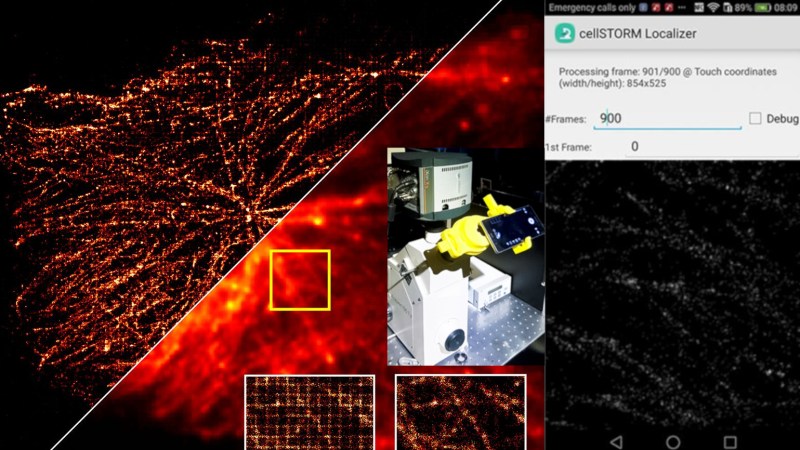Mobile phones are the photography tool for most of us, but they are a blunt tool. If you love astrophotography, you buy a DSLR and a lens adapter. Infrared photography needs camera surgery or a special unit. If you want to look closer to home, you may have a microscope with a CCD. Your pocket computer is not manufactured for microscopy, but that does not mean it cannot be convinced. Most of us have held our lens up to the eyepiece of some binoculars or a microscope, and it sort of works, but it is far from perfect. [Benedict Diederich] and a team are proving that we can get darn beautiful images with a microscope, a phone holder, and some purpose-built software on an Android phone with their cellSTORM.
The trick to getting useful images is to compare a series of pictures and figure out which pixels matter and which ones are noisy. Imagine someone shows you grainy nighttime footage from an outdoor security camera. When you pause, it looks like hot garbage, and you can’t tell the difference between a patio chair and a shrubbery. As it plays, the noisy pixels bounce around, and you figure out you’re looking at a spruce bush, and that is roughly how the software parses out a crisp image. At the cost of frame rate, you get clarity, which is why you need a phone holder. Some of their tests took minutes, so astrophotography might not fare as well.
We love high-resolution pictures of tiny things and that isn’t going to change anytime soon.
Thank you [Dr. Nicolás De Francesco] for the tip.
















It’s not heavy duty but it works, look out for these, Toys’R’us used to have them, they may turn up in liquidation/surplus stores… https://www.amazon.com/Science-Telescope-Microscope-Device-Adapter/dp/B01NBCQUU0
Is this technology fit to study #coronavirus ?
Maybe in a few more months we’ll need to hack some up for the last surviving scientists, the spendy equipment being lost in the forbidden zones, or areas that got panic nuked.
No. Viruses are too small to use a conventional microscope for.
>While the size of the new virus is currently unknown, human coronaviruses are generally about 125 nanometers, so there’s reason to believe this coronavirus follows suit.
You’ll need a “light” source below 120nm before you can resolve it.
FYI: visual spectrum 380 – 750nm
STORM microscopy has a resolution of approx 20 nm. It manages to overcome the wavelength optical limitation.
You would need much finer resolution than 20nm to look at a very complex structure that is 120nm.
https://www.livescience.com/coronavirus-spike-protein-structure.html
That’s just the tiny spike (flower stalks) on the surface and not close to the whole thing.
Have to remember that resolve != detect. Benefit of fluorescence microscopy is that if the thing you want to see is the only thing labeled in that spectral band and those are isolated from one another, it is straightforward to see (ie detect) individual particles down to single molecules. This is how STORM works in the first place, where the item being detected is a single organic dye molecule at a time.
Tagging a virus with one or more dye molecules renders it visible. Without any other confounding signal, it is absolutely possible to see individual viruses with this or similar fluorescence microscopy techniques.
should buy usb microscope in shopping mall, coming with 3 lenses for tests ?
If you love astrophotography you buy a cooled monochrome camera and a filter wheel. You can use dslr but there is a whole lot more noise because the sensors get hot during long exposures.
Neat. I didn’t know that.
You haven’t understood how STORM imaging works. I’m afraid you don’t “figure out which pixels matter and which ones are noisy.” The trick is to ensure that most of the fluorescent molecules are not fluorescing at all. The molecules that emit at all are then isolated enough to be localised to very high precision, much higher than the resolution of the microscope. You then take thousands of images each with a different set of molecules active and assemble a final image from all of the localisations you measure.
This wont work on my your average USB microscope as a) it wont do fluorescence, b) even if it did it wouldn’t have enough illumination power to do STORM, c) it doesn’t have enough sensitivity to pick up the fluorescence emission from a single molecule and d) its doesn’t have enough resolution either. Notice this group connect their cell phone camera to a real research microscope, a Zeiss axiovert. Notice as well that their other camera is a £15,000 EMCCD camera, more usually used for these types of experiment.
Hey, fun to see our work on hackaday. There will be a second cellSTORM omitting the ZEISS axiovert entirely. Keeping everything in a “USB-webcam microscop-ish” fashion (at least <1000€) to detect – wait for it – corona virus. Should be available as a preprint soon!
It’s fun to see cool stuff like yours and write about it!